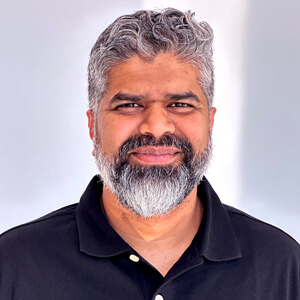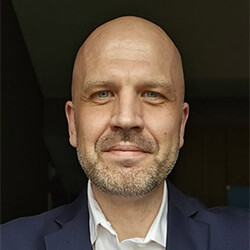TechTalk Getting Started With Computer Vision (Part 3)
Discover how organizations make the leap from excitement around the possibility of adopting computer vision to real, tangible results.
By Insight Editor / 30 Mar 2021 / Topics: Data and AI
By Insight Editor / 30 Mar 2021 / Topics: Data and AI
Identifying the right opportunities for innovation can help your business drive value quickly. In the conclusion of this three-part series, Insight Digital Innovation’s Amol Ajgaonkar, Ken Seier and Ben Kotvis discuss key first steps for organizations developing a computer vision strategy.
To experience this week’s episode, listen on the player above, watch the conversation below, or scroll down to read a complete transcript. You can also subscribe to Insight TechTalk on Apple Podcasts, Pandora, and Spotify.
Audio transcript:
Published March 30, 2021
BEN
Hello everyone. And welcome to today's Tech Talk, Getting started with Computer Vision. I'm your host, Ben Kotvis, Chief Architect of IoT. And joining me today are my colleagues, Amol Ajgaonkar CTO of Intelligent Edge for Insight and Ken Seier Insights National Practice Lead for Data and AI.
Thank you both for being here.
KEN
Thank you Ben.
AMOL
Thank you Ben.
BEN
In the last two episodes of the series, we've talked about the benefits of Computer Vision and some of the innovative ways it can be applied across industries. Today we'll take a more technical look at how these projects are developed and implemented. Both from a functional and operational perspective. Let's first talk about how most organizations get started with Computer Vision project.
In your experience, Ken, what does this look like?
KEN
Many companies get really excited about the potential of Computer Vision, and they should. But often, they try to tackle a problem that's just a little too complicated and maybe not as directly implementable as they might want. We really like to see the companies that we work with focusing on those first cases that can drive real business value quickly, minimum of effort, maximum impact.
BEN
How about you Amol?
AMOL
And I think what they also miss upon sometimes is the understanding of what it would take to operationalize this. What does it take to get it into production and scale it out? So, if you don't take that into concentration you will never understand the total cost of that solution and then compare it to the value that it brings back to the organization. So, the comparison of a solution, cost of a solution holistically, and then the value that it brings becomes as super important so that you understand if it's of real value, there is ROI there or not.
So, I think that is where sometimes customers miss that part of understanding the costs and, and challenge of operationalizing it and scaling it. And they get excited about the technology itself and they dive directly into the solution.
BEN
Sticking with you, Amol, for a minute. Once they've gotten buy in from leadership to explore whether Computer Vision is the best solution for a particular challenge, what's the first step in kicking off that initiative?
AMOL
I think the way we approach this with our customers is talk about the end-to-end solution. And then when you're talking about the solution holistically, planning each phase of it. Right from selecting the right team that is required. Not just from our teams but also from the business side. The customer's team that needs to be involved and how much involvement is required from their teams to make sure that we have a good product at the end. Always having, the goal in mind and what are we trying to achieve So on that journey, there are many opportunities to deviate because there'll be something more exciting more information will come through. Pivoting is important. Adapting is important but making sure that the ROI the goal that we've laid out at the beginning, we achieve that. And then having a plan for training the data, testing it and operationalizing the model.
And when I say operationalizing the model not just that it's been in production and now we are done what happens after that? How do we have a support, plan in place? Who's going to take the support calls? How are we going to maintain the Edge devices? How are we going to maintain the models? Everything has to be considered holistically, have a plan together and then move forward. And I think it just starts right from even from like data collection and getting to into the nitty gritty right here. Data collection strategy the processing, the testing, defining an MLOps strategy on how are you going to update the models? How are you going to retrain the model? How are you going to version the model?
Bringing that complete, structure and defining it as an Edge strategy becomes super helpful. Ken.
KEN
Absolutely. So we really like to work hand in hand with our customers to drive that entire process in an end-to-end pilot. We want to create a minimum viable product that drives that value that has as few complications as possible. So that we can get them from ideation and help them identify that correct use case that's going to drive that value. That's going to have the right level of complexity and implementation. That's going to have the right executive support in order to get over that finish line. And take them through that entire process. With the data collection, the data labeling the model building, the model validation the deployment, the monitoring, the automated retraining. Often, customers call this the last mile. I think about 85% of projects fail trying to get into production. And the thing that I really need to impress on our customers is that's not the last mile. The last mile is when it finally comes back to driving real business value and users have accepted it.
So, once you have it productionalized, once you have it in your ecosystem, once you have it monitored and retrained you also need to integrate it back into your business systems. You need to show people how to use it. You need to make it intuitive so that people don't need training. You need to get it into the business process and then you need to observe how the business process changes. AI is extremely disruptive. AI can have huge impact and create all new business models for operation, and you need to capture those back.
So, you need to create this holistic cycle of this virtuous cycle of analytics improvement and AI improvement. That iteratively drives more value into the business, through Artificial Intelligence integration into your business and customer ecosystems.
BEN
So, Amol, what is the long-term considerations for Computer Vision? Once you've implemented a successful proof of concept, how do you operationalize it at scale?
AMOL
So, I think when you're planning for the proof of concept I think the planning for production starts then, because you need to understand, for the proof of concept, you might collect data, you might build a model you might prove it out and be like, "yep," it's all good. But, there are so many parts of that process that right now you've done manually that need to be automated. So, thinking about those automations when you deploy that scale becomes super important.
Second is, you've built a model, you have it in the cloud and you have your Intelligent Edge or your compute really close to the cameras themselves, and you are running the model there. The second part is, great now you've collected more data. You've trained the model. How am I going to deploy and update that model that's already at the Edge? And you might have hundreds of locations. So MLOps is super important there because unless you have that complete life cycle that complete loop, done for Computer Vision Models or any AI models frankly, you're going to reach, you're going to hit a plateau where you won't see additional value coming out of that model.
So, it becomes super important that we collect the data, we train the model and then we have a way to actually push the model back down to the Edge devices and almost do AB kind of testing or to say, "okay, I'm going to run a few frames through my original model, see what I get, and then I run it through my newer model and see what I get." Am I getting better accurate? Am I getting different results? And then making the decision to switch it up. And we do this with DevOps. We do this with using DevOps for any type of application. That's why DevOps is for application and MLOps is required, it's not optional. It is required for any solution, any AI solution in Computer Vision solution to be deployed at scale into production. So, having those two processes in place becomes super important.
And then third, is once you have deployed this you have the MLOps in place. You you're seeing the value. Now, interestingly, you still have to maintain the head Edge device that you have and on-prem in a hundred different location. That means you have to patch it, you have to make sure that it's up and running. You have to make sure that you have connectivity. All of those things have to be taken into concentration. So, having a managed Edge service almost where, somebody else, we can do that obviously, but having somebody else to look at those Edge devices and monitor those and understand what patch level they are at and understand that it's down and needs to be rebooted, somebody by mistake, switched it off being able to turn it on remotely. All of those services become super important when you actually deploy these solutions at scale.
BEN
Ken, I saw an interesting article yesterday about a trained AI model, a very popular one, where there was an Apple where the model identify the Apple and then somebody wrote it had an Apple underneath it with a little label on it that said iPad. And it incorrectly thought the next Apple was an iPad. Cause somebody wrote that on there. So, when we talk about kind of operationalization and just kind of taking these things for production obviously the accuracy, as Amol just mentioned, is really important. What are the other considerations that you have?
KEN
Sure. That was a great example of an adversarial attack. The operators had created a model that had a number of positive, negative training images. They thought they had covered all of the scenarios that would be in that environment. They trained the model, worked very well as expected. And then someone did something unexpected. And because this Computer Vision and all AI are really narrow intelligences, it couldn't compensate. It couldn't think outside of the little box it was trained in, and it just failed.
So, what we need to do is make sure that all of these great technical capabilities of ideation and data collection and MLOps and business integration are wrapped in a living breathing business process that can respond to dynamic changes. It needs to respond when the technology changes, it needs to respond when the data inputs change, and the models go out of tune. It needs to change when the business environment changes. You need to have an interdisciplinary group of people guiding and advising your organization on how to evolve your AI strategy.
AI is in its infancy. We are still learning how to implement it. We are still learning how it changes human lives. And every company is at the forefront of AI. Every market is being transformed by AI and companies need to be prepared to respond to that. And the companies that build that first, who get to that MLOps maturity, who get to that AI maturity who get to that process and business maturity around AI, are going to be the ones driving disruption in their market. They're going to be the ones changing the way that everyone does business. And they're going to be creating the new business models that will succeed in the next generation. And we want to help our customers get there.
BEN
That's all we have time for today. Thank you both for lending your expertise throughout the series. And thanks to everyone for watching. Don't forget, we held two prior series, series one and two, if you'd like to learn more about Computer Vision, be sure to check out Ken and Amol's latest article in the Tech Journal. And if you're interested in seeing how Ken, Amol and the rest of the Insight Team can help your businesses get started with Computer Vision, get in touch with us by requesting discovery session below.
Thank you everyone.
KEN
Thanks Ben.
AMOL
Thanks Ben.
[Music]

CTO, Product Innovation, Insight
Amol draws upon two decades of experience to drive thought leadership and strategy for outcomes-focused solutions. He is a technology leader with a passion for operationalizing Intellectual Property (IP) and fostering innovation to create customer-focused offerings and accelerators. His expertise lies in transforming innovative ideas into practical solutions, aligning them with customer needs and optimizing their implementation within the company. Amol excels in orchestrating cross-functional teams, fostering collaboration and building strategic partnerships to deliver results.

National Practice Lead for Data & AI, Insight
Ken is passionate about driving analytics innovation with measurable outcomes and real business value. Ken and his team have been responsible for billions of dollars of revenue and savings through responsible analytics initiatives and innovation.

Principal Architect, Insight
Ben has had a long career in software architecture in which his hunger for finding new and innovative ways to improve processes landed him in a software engineering role 20 years ago. Since then, he has served some of the largest organizations in the world as a consultant and subject matter expert in software development, architecture, IoT and microservices. He served as a chief architect and worked closely with partners like Microsoft, Intel, and Google, presenting solution all over the world. He excels in his ability to understand a problem from a broad perspective, break the pieces apart, and provide practical solutions that are robust and easy to understand. What he finds most rewarding is to mentor colleagues and clients in a manner that empowers them to innovate on their own and advance their career long term.
Receive automatic notifications when new episodes are released.